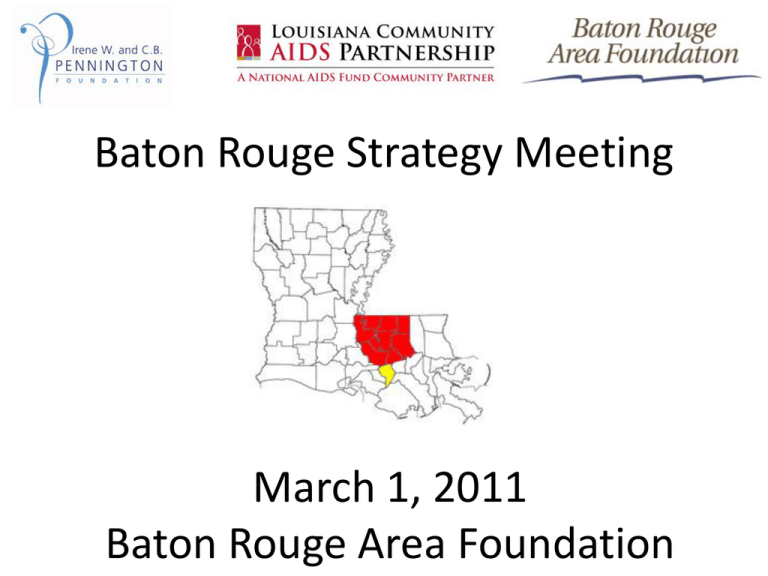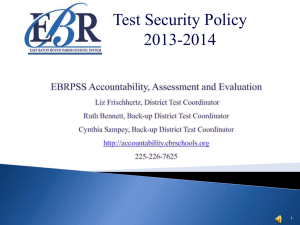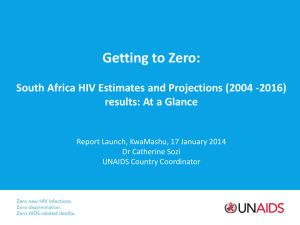
Baton Rouge Strategy Meeting
March 1, 2011
Baton Rouge Area Foundation
Afternoon Goals
• Present information on HIV/AIDS data for the
Baton Rouge MSA
• Identify an HIV prevention strategy or set of
strategies that are community defined and
driven
• Devise an action plan for community
mobilization around the identified prevention
strategy or strategies
Understanding Baton Rouge’s AIDS
Case Rate
• What is the Baton Rouge MSA?
– Baton Rouge Metropolitan Statistical Area (MSA) is
9 parishes
•
•
•
•
•
•
•
•
•
Ascension
East Baton Rouge
East Feliciana
Iberville
Livingston
Pointe Coupee
St. Helena
West Baton Rouge
West Feliciana
Baton Rouge MSA
• Population and Demographics
– 2009 Total Population is 786,947
• 11.5% increase since 2000
–
–
–
–
–
–
–
49% Female, 51% Male
60% White
36.5% Black
2.3% Hispanic
1.7% Asian
Median Age 33.7 years (national is 36.3)
Almost 85% of people age 25+ are high school
graduates
Quick Definitions
• Incidence: The number of newly diagnosed cases of a
disease (New HIV cases, New AIDS cases)
• Prevalence: The total number of cases of disease
existing in a population (Persons living with HIV/AIDS)
Incidence
Prevalence
Death
Incidence – Baton Rouge MSA
2009
• 2009: 331 persons newly diagnosed with HIV
• 2009: 216 persons newly diagnosed with AIDS
NEW HIV CASES
NEW AIDS CASES
Sex
Females
Males
37%
63%
38%
62%
Race
Black
White
Hispanic
86%
12%
1%
86%
13%
1%
Age at Diagnosis
Under 25
25-44
45 and Older
27%
47%
26%
11%
53%
36%
HIV Case Rate by Louisiana MSA
2000-2009
Baton Rouge MSA
New Orleans MSA
50
HIV Case Rate per 100,000
45
40
35
30
25
20
15
10
5
0
2000
2001
2002
2003
2004
2005
2006
Year of HIV Diagnosis
2007
2008
2009
AIDS Case Rate by Louisiana MSA
2000-2009
Baton Rouge MSA
New Orleans MSA
40
AIDS Case Rate per 100,000
35
30
25
20
15
10
5
0
2000
2001
2002
2003
2004
2005
2006
Year of AIDS Diagnosis
2007
2008
2009
2008 Estimated AIDS Case Rates
US Metropolitan Areas
45
40
35
Case Rate
(per 100,000)
30
25
20
42.8
40.0
Southern MSA’s
32.4 32.3
26.9 25.9
25.6 25.3 24.6
23.0
20.9 20.5
19.5 19.1 18.8
18.1 17.3 17.1
16.5 16.1
15
10
5
0
CDC 2008 HIV Surveillance Report, Vol 20
Persons Living in the Baton Rouge MSA
2000-2009
5,000
4,352
Number of Persons LIving
4,500
4,000
3,500
3,000
2,816
2,978
3,157
3,258
2002
2003
3,428
3,628
3,770
3,919
4,078
2,500
2,000
1,500
1,000
500
0
2000
2001
2004
2005
Year
2006
2007
2008
2009
Is Baton Rouge at a disadvantage
statistically because of the number of
prisons in the MSA?
• 2009 the BR MSA had a HIV Prevalence rate of
553 per 100,000. If you take out the prisoners
(in state correctional facilities only) this only
drops to 506 per 100,000.
• Removing prisons does not account for high
prevalence rates in the BR MSA
Persons Unaware of Status
• The CDC estimates that 21% of all people
infected with HIV are unaware of their HIV
status.
• If you apply this percentage to the Baton
Rouge MSA:
– 1,208 persons living with HIV in the Baton Rouge
MSA who have not been diagnosed and are
unaware they are infected.
What C&T sites identify the most new
positives?
Identification of new infections between 10/1/09-9/30/10
•
•
•
•
•
•
•
•
OPH Region 2 STD clinic – 30 (1.0% positivity)
EKL ER – 24 (1.3% positivity)
Metro - Main office – 17 (2.0% positivity)
Metro - Mobile unit – 12 (2.1% positivity)
Capital City – 12 (2.0% positivity)
Hunt Correctional – 8 (.2% positivity)
East Baton Rouge PHU – 6 (.5% positivity)
Metro - EBR Parish prison – 5 (1.6% positivity)
***Example- for Hunt to identify 8 new infections,
they tested over 4000 individuals***
What are the sub-populations and risk
categories we should be concerned
about?
•
•
•
•
•
•
•
African American Men
MSM
IDU
Prisoners
Youth
Pregnant Women, Exposed babies
Transgender individuals
Overview of Programs already provided by
CBOs in the Baton Rouge MSA
Agency
HIV
C&T
Evidence
Based
Interventions
Social
Marketing
Case
Management
Medical
Care
HIV
Treatment
(Medicatio
ns)
FSGBR
VOA
YWCA
Metro Health
BRASS
YMCA
Other
supportive
services for
PLWH/A
Overview of Programs already provided by
CBOs in the Baton Rouge MSA- continued…
Agency
HIV
C&T
Capitol Area
Phoenix Initiative
EKL-Early
Intervention
Clinic
Capitol Area
Reentry Program
HAART, Inc.
Planned
Parenthood
Our Lady of the
Lake
Evidence
Based
Interventions
Social
Marketing
Case
Management
Medical
Care
HIV
Treatment
Other
supportive
services for
PLWH/A
Overview of Programs already provided by
CBOs in the Baton Rouge MSA- continued…
Agency
HIV
C&T
Women’s
Hospital
Evidence
Based
Interventions
Social
Marketing
Case
Management
Medical
Care
HIV
Treatment
Baton Rouge
Area Alcohol and
Drug Center
AIDSLaw
Capitol City
Family Health
Center
Face to Face
Other
supportive
services for
PLWH/A
Map of Services- Whole MSA
Map of Services- City of Baton Rouge
How much investment is going into program categories
Program Category and Funding Source
Estimated Amount Designated for the
Baton Rouge MSA
Services
Ryan White Part A
$3,117,985
Ryan White MAI
$292,595
ADAP (25% of state total)
$5,151,350
Prevention
C&T
$961,122
Condoms
$56,306
Behavioral Interventions & Outreach
$296,042
DIS and other staff
$548,905
Capacity Building and other gap funding
Pennington and LCAP*
~$285,000
*LCAP- Includes funding from AIDS United (National AIDS Fund) Baton Rouge Area Foundation,
Wilson Foundation, Pennington Foundation, Keller Family Foundation, OPH-SHP and others
Overview of the State’s HIV/AIDS
Prevention Funding Categories
From the OPH STD/HIV Solicitation of Offers$1,100,000 (25% likely to go to Region 2):
• HIV Counseling, Testing and Referral/Linkage;
• HIV Screening and Referral/Linkage;
• HIV Testing through Social Networks;
• STD Screening;
• Prevention Materials Availability;
• Programs Targeting Men Who Have Sex with
Men;
• Outreach, Referral and Linkage;
• Prevention With Positives
Overview of the City’s Ryan White
Funding Categories
From the Baton Rouge Part A Application- $3,825,000:
• Ambulatory Outpatient Medical Care;
• AIDS Pharmaceutical Assistance (Local);
• Oral Health;
• Early Intervention Services;
• Medical Case Management;
• Mental Health Services;
• Substance Abuse Outpatient Services;
• Non-Medical Case Management;
• Food Bank;
• Legal Services;
• Psychosocial Support Services;
• Emergency Financial Assistance;
• Medical Transportation;
• Outreach.
Our Collective Community-Level Goal
Decreasing/preventing the number of people
who test positive for HIV and other STDs in
Baton Rouge MSA
If this is the goal- where are the gaps?
Exercise: Group Discussion and identification of
programming gaps
Suggested menu of most promising Community
Based HIV Prevention Practices
•
•
•
•
Information, education, and communication (IEC)
– HIV/AIDS Awareness Social Marketing Campaign
– HIV/AIDS & STD 101; awareness raising
– School-based sex education
– Condom promotion & distribution
Expanded HIV Counseling & Testing
– MSA-wide testing campaign: Example DC or Oakland
– Opt-out testing in Emergency Rooms
– Social Network Testing
– School Based Clinic Testing
– Community Health Center Testing
Evidence based interventions
– SISTA; Many Men Many Voices; Mpowerment; Project Respect; Willow; SIHLE
Expanded Services
– Access to care
– Housing
– Access to medication
– Transportation
Criteria for choosing strategies
• Reach- The strategy is likely to affect a large
percentage of the target population.
• Mutability- The strategy is in the realm of the
community’s control.
• Transferability- The strategy can be implemented
in communities that differ in size, resources, and
demographics.
• Effect size- The potential magnitude of the health
effect for the strategy is meaningful.
• Sustainability of health impact- The health effect
of the strategy will endure over time.
Community Mobilization FrameworkWhat is your role?
Working on getting a better version of this graphic!!!
Group Exercise to Devise a Community
Mobilization Plan
•
•
•
•
Group 1- Information, Education, Communication
– What type of media vehicle?
– Targeted at whom?
– What resources are needed?
– How does it match up against the criteria?
Group 2 – Expanded HIV Counseling & Testing
– What type of sites?
– Targeted at whom?
– What resources are needed?
– How does it match up against the criteria?
Group 3- Evidence Based Interventions
– Who should be targeted? (Community level, group, individual?)
– What intervention(s) are best suited to fit the need?
– What resources are needed?
– How does it match up against the criteria
Group 4- Expanded Services
– What service gaps exist?
– What is achievable through community mobilization?
– What resources are needed?
– How does it match up against the criteria?
Group Exercise
•
•
•
•
•
•
Break up into your 4 groups
Answer questions on the previous slide…then
What action steps can you take to endorse?
What action steps can you take to support?
What action steps can you take to participate?
What action steps can you take to build action
coalitions?
Remember: You and your organization are
change agents!
Deliverables
• How intervention rates again criteria
• List of action steps that can realistically be
done
• Schedule next group meeting time and
location
• Make sure your call to action is completedsubmit top part to us and keep the bottom for
yourself
Group Reports: Action Steps for
Mobilizing the Community Around our
Goals
• Action steps from afternoon group reports
• Feedback and critique from morning training
participants
Next steps after today
• Build a community mobilization action plan
document
• Disseminate amongst today’s participants and
other Baton Rouge MSA stakeholders
• Others?
Questions about today?
Please contact:
Susan Bergson
Louisiana Public Health Institute/Louisiana
Community AIDS Partnership
sbergson@lphi.org; 504-908-1904
Michael Robinson
mrobinson@lphi.org; 504-301-9800







